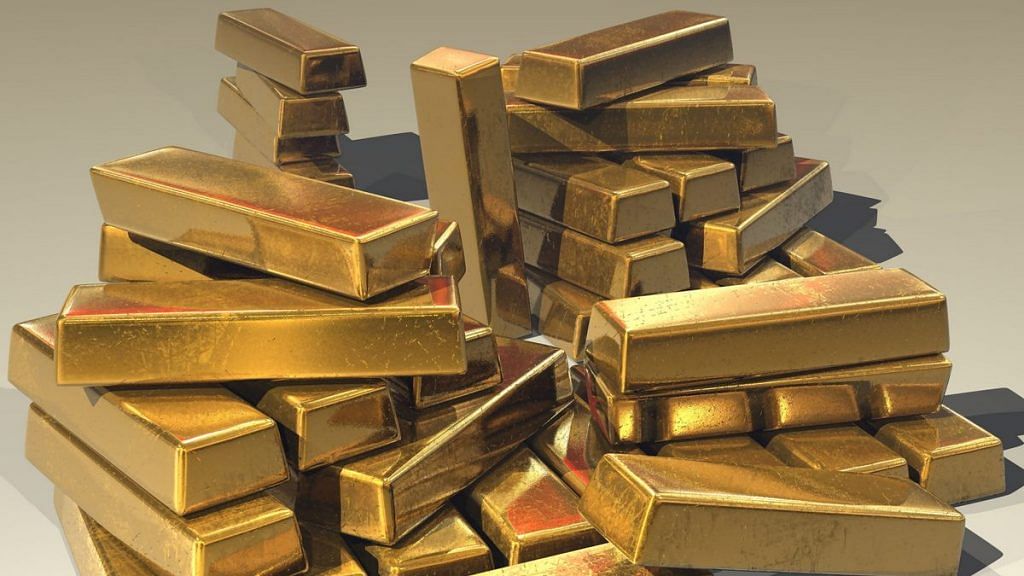New Delhi: When the Economic Times reported last week that the Reserve Bank of India may be selling gold, and used data from the central bank’s weekly statistical supplement to back its claim, it was a cause for alarm as the move was seen as another indication of how dire India’s economic crisis had become.
The RBI, however, was quick to deny the report and attributed the change in gold holdings valuation to a change in the frequency of the valuation.
Reports have appeared in certain sections of media that RBI has been selling/ trading in gold of late. It is clarified that RBI has not sold any gold or trading in it. (1/1)
— ReserveBankOfIndia (@RBI) October 27, 2019
The fluctuation in value depicted in Weekly Statistical Supplement (WSS) is due to change in frequency of revaluation from monthly to weekly basis and is based on international prices of gold and exchange rates. (2/2)
— ReserveBankOfIndia (@RBI) October 27, 2019
Data shows that the RBI, with its 618.2 tonnes of gold holdings as of August-end, is among the top 10 central banks in the world in terms of gold reserves.
Over the last two years, the RBI has been constantly increasing its gold reserves, data from the World Gold Council shows, as it looks to add to its gold holdings to diversify its reserves away from the dollar.
ThePrint looks at why selling gold is considered a sign of stress in the economy.
Also read: Indians are buying less gold and millennials are partly to blame
Composition of India’s foreign exchange reserves
India’s gold reserves were valued at $26.86 billion or Rs 1.91 lakh crore as on 18 October 2019, while the total foreign exchange reserves were at $440.7 billion, according to RBI data.
This means India’s gold holdings constitute 6.1 per cent of the total foreign exchange reserves, while approximately 93 per cent of the reserves are in foreign currency assets in different currencies like the US dollar and the Euro. The remaining is in special drawing rights and Reserve Position with the International Monetary Fund.
Why gold reserves value can change without change in quantity
The value of the gold reserves can change even without a physical change in the quantity of gold held, on account of change in gold prices and fluctuation in exchange rates.
Foreign currency assets also keep changing depending on the performance of the currencies in the Indian basket. This is termed as the revaluation effect.
Also read: High gold prices, economic slowdown dull Dhanteras sales
Why a central bank selling gold is a sign of crisis
The initial news report about sale of gold by the RBI triggered a wave of concern about the health of the economy, since the last time the central bank had to pledge its gold holdings was at the time of the financial crisis in 1991, when the dwindling foreign exchange reserves were insufficient to meet India’s import bill for essential commodities.
At the time, India pledged 67 tonnes of its gold reserves to the Bank of England and the Union Bank of Switzerland for $600 million to tide over its balance of payments crisis.
Given the present fragile state of the Indian economy and the RBI’s decision to transfer Rs 1.76 lakh crore to the government following the recommendations of the Bimal Jalan panel, there was speculation that the central bank was trying to raise resources through the sale of gold holdings.
Also read: Silver glitters in India as record prices dull gold’s luster
When did India start augmenting gold holdings?
India’s gold reserves were as low as 358 tonnes when D. Subbarao assumed charge as the RBI governor in September 2008. In the aftermath of the global financial crisis, India bought 200 tonnes of gold from the International Monetary Fund in 2009.
India then resumed gold buying in 2018, data from the World Gold Council shows, adding more than 60 tonnes to its reserves in the last 18 months.
In an article published in GoldHub last month, Subbarao explained the rationale of the bulk purchase during his tenure, which saw India’s gold holdings increase by more than 55 per cent.
“Gold is a good long-term investment and a reliable reserve asset,” he said, pointing out that if emerging markets cannot rely on the dollar as a guard against exchange rate instability, then they have little option but to build their own defences.
“Holding gold within our reserves is an integral part of that self-defence,” he said.
Central banks across the world are increasing gold holdings
Many central banks have been increasing their gold holdings. In 2018, central banks around the world were net purchasers of 651 tonnes of gold, the highest since the collapse of the Bretton Woods system nearly 50 years ago.
The World Gold Council attributes the increase in holdings to rising geo-political tensions, political and economic factors and structural changes in the global economy.
“Gold is the only reserve asset that bears no political or credit risk, nor can it be devalued by the printing presses or extraordinary monetary policy measures,” the council said in a report released in September 2019, titled ‘A central banker’s guide to gold as a reserve asset’.
(This report has been updated to correctly reflect the amount RBI has decided to transfer to the government following the recommendations of the Bimal Jalan panel.)
Also read: Modi & his top ministers are risk-averse, invest their money in gold, FDs and land
